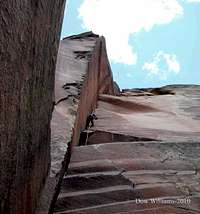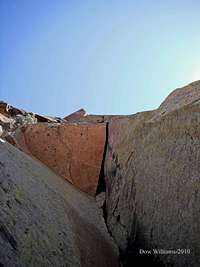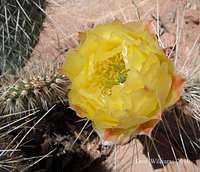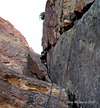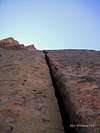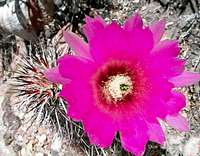-
 12616 Hits
12616 Hits
-
 87.76% Score
87.76% Score
-
 25 Votes
25 Votes
|
|
Route |
|---|---|
|
|
36.11206°N / 115.48907°W |
|
|
Trad Climbing |
|
|
Spring, Summer, Fall, Winter |
|
|
Most of a day |
|
|
5.11d (YDS) |
|
|
7 |
|
|
Overview/Approach
Zach and I had Cloud Tower on our minds for quite some time. This infamous route at Red Rocks made it high on my list when I climbed the north face of Castleton Tower in 2009. We just finished rapping this stellar 5.11 desert crack line and ran into some locals at the base getting ready for an evening ascent of the same route. One gentleman indicated it was approximately his 20th ascent of the north face Castleton route. During that discussion, he mentioned that he liked Cloud Tower over in Red Rocks even more, this coming from a Moab local. That created quite the emphasis for me to climb Cloud Tower.
I actually got up the route twice in four days. The first trip was based on a late decision on a lazy day when plans changed due to wind. One of my partners mentioned Cloud Tower and I considered the route to be fairly protected from the wind, so we went for it but did not climb the last pitch due to the rack we had available. In three days I immediately returned to Red Rocks with Zach and we climbed it in style, a true red point for the respective pitch leaders, from bottom to top. With 60m doubles, we completed the route in five total pitches with a short amount of simul climbing at the beginning. I highly recommend a single 70m rope. A competent individual can rig the descent with a 70m rope in my opinion.
Van Betten and company established the route in 1983. I have read some summit logs reflect that the Cloud Tower line is a bit contrived, but by Red Rocks standards, the individual pitches, via their own merit, offer full value. As before mentioned, I prefer to combine the first two 5.8 pitches to the large ledge above. From there a sweet, but rather short, 5.10a perfect hand crack awaits up and left. The second pitch itself is rather long, but the hand crack portion is relatively short. Once through the hand crack, make a face traverse up and left to a small stance at a fixed belay below the crux of the route. The fourth pitch involves an awkward and strenuous finger crack. Stemming is essential through the first half of this pitch, but then one must commit to the crack. The pitch eats up tons of small gear and can be easily aided through. It finishes in a small alcove box of sorts below a roof and hand crack above. The fifth and sixth pitches are easily combined for a full 60m worth of fun 5.10 climbing. They start with a fun roof pull into a hand crack on excellent rock with tons of rests as it widens to 4” gear towards the top. It eventually angles left and finishes through a small tunnel/chimney where you pop out to the other side in bright sunshine. The last pitch is the prize of this route. Zach and I both wondered how could a hand crack could be 5.11+? Well it was full on athletic jamming, with little rest along the way, finishing through a bold overhang (crux). The right face on this pitch is fascinating. You are basically surfing up waves of sandstone via jams.
Park at the Oak Creek trail head off of the Red Rocks loop road. Hike straight out north of the parking area on an established trail heading for Juniper Canyon. Take your first right at a T and then two lefts that lead you to a massive boulder out in the middle of the wash. Follow the wash up creek a bit until you can intersect a rather indistinct trail veering up and left. Follow this trial which becomes more prominent as it makes for the large ramp that leads to the base of Crimson Chrysalis on Cloud Tower. Once your crest the ramp, head down the base of the wall for about 200’ or so to an obvious left facing varnished corner with several trees growing out of it that is about 200’ tall.
Route Description
800’+/-, 7 Pitches, 511d1st-2nd Pitches- 220’- 5.8/ Handren has these first two pitches at 240’, but that is a bit long. With a 70m rope you can combine these two pitches. We simul climbed for a short bit to get them combined with 60m ropes. These first two pitches make up a classic Red Rocks 5.8 corner at about the same grade as most of Crimson Chrysalis on even better and cleaner varnished rock. Take the corner past a few trees and past a slung tree on a small ledge and belay off of larger trees on a large ledge above the corner.
3rd Pitch- 180’- 5.10a/ From the top of the second pitch belay this pitch is quite a bit longer than Handren has it marked up in his guide. However, the first 50’ or so is mostly just fifth class ground until you reach the base of the hand crack. Run up the beautiful hand crack placing gear at will for less than 100’ to a small ledge. Make a stem move or two to traverse up and left from this ledge onto large positive face holds that angle up and left to a small stance ledge and fixed belay below the arching crux pitch of Cloud Tower.
4th Pitch- 100’- 5.11d/ Although this is not the most sustained pitch of the route, this pitch does own the crux moves of Cloud Tower. Move up and left to clip an old bolt and catch a small mossy ramp that angles back right. Several solid nut placements protect this ramp, until you reach some small edges that work you back left into the base of the (no doubt) well chalked up arching corner. You can place endless amounts of small gear (C3’s and 00-0) as you ascend this corner. You will pass one more old bolt out right on the face that is really not needed and one fixed cam (2010). At first, stem out wide left, throwing your right foot up to the broken varnished patches to avoid the slick varnished face. The real trick for me the second time was to almost climb straight up the overhanging and reachy left holds via several tremendous jugs gaining a lot of ground before having to hit the strenuous stemming again. Eventually the stemming runs out and you have to commit to the small finger corner. A few lay back moves and some quick feet will get you to a few edges and waves that lead into easy climbing to finish off into the large alcove/box above. Climb up to the second ledge in the alcove, about 15’ below the roof.
5th-6th Pitches- 200’- 5.10c/ Take the roof. I prefer not to place any pro until the very lip of the roof (2”) for rope drag purposes. Throw a perfect hand jam above and heave yourself up onto the face and into the crack. Three 3” pieces are handy for the first half of the tall crack, followed by two 4” pieces and .75” protects inside the much larger portion above as the crack ends. There are plenty of rests up this steep crack and I felt it was a bit soft for 5.10c. When the crack widens and turns left, follow it up to easier ground. Chimney through to the other side of the wall, staying high enough to step down on the belay ledge across the chasm. There is no gear for this section and the final move involves a tight squeeze, but the climbing is easy. Belay off 1” gear and enjoy the new found sun, normally the first you see en route route. In 2010 a Falcon was nesting across the ledge below.
7th Pitch- 110’- 5.11c/ Wow, what a pitch and definitely the crown jewel of this route and possibly in all of Red Rocks. Follow the hand crack to the top of the pitch. At first, easy 1-2” crack climbing gets you 20’ above the belay. Then full on jamming with little for feet is required to get up and over the first wave of sandstone. We took several 1”, three 2”, two 2.75”, one each 3” and 4”. That makes for a pretty good rack for this last pitch. Many won’t have the energy to punch in a lot of gear towards the end. The last 10’ involves the crux and most required power climbing all day, converting from a quick lay backing section to a full on jam mantle up and over a bulging wave of sandstone to the anchor. Good stuff to be sure!
Climbing Sequence
Descent
I advise a 70m rope for descent but did not actually use one yet, so my description is for double 60m ropes. Rap from the top of the route to the broad ledge below. Rap from a fixed station there on a single rope to a tree directly below the ledge (short rap). Then rap from that tree down to climbers left to another tree. If you try to rap from the ledge to that second tree below, I would think your knot would have a hard time passing the lip of the ledge, although it would reach if you want to try it. But it won’t reach if you pull the knot over the lip. From the lower tree, another double 60m rap gets you to a large ledge that is the same as for the top of the second pitch. Traverse east back to the top of the second pitch and make one last double rope rap to the ground. However, I have done this twice and both times, had to walk my rope way out north to pull it. To save time, I believe you are better off making use of the slung tree at the top of the first pitch. One single rope rap to that and then a double rope rap to the bottom. Again, a 70m rope would make this whole descent much more efficient in my estimation. The very top rap can be done with a 70m if the first to descend puts in a directional or two back to the belay ledge which has a slung block that can be short rapped to the main sloping ledge which starts the rest of the raps with numerous trees to chose from.


